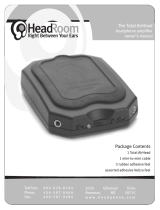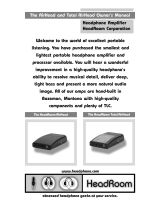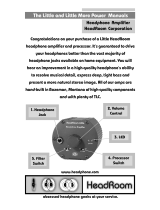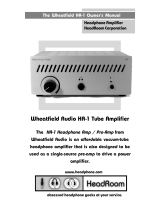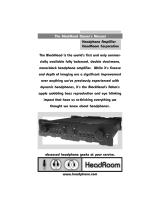Page is loading ...

the AirHead
the Total AirHead
portable headphone amplifier
Owner’s Manual
obsessed headphone geeks at your service.
www.headphone.com
1 AirHead/Total AirHead
headphone amplifier
3 rubber adhesive feet
assorted adhesive Velcro feet
1 owner’s manual
1 mini-to-mini cable
Package Contents

Hold your AirHead so that controls are facing you and the rubber battery door is up. Across
the front of the AirHead are a number of connections and controls.
5.
6.
7.
2
Getting to Know Your AirHead Amplifier
On the far left is one of two headphone jacks that fit any 1/8” (mini) headphone plug.
(An adapter is needed if your headphones are terminated to a 1/4” plug.)
The first switch on the left is the power switch. Turn the power switch to the right, to ON,
in order for the amp to function (for both battery pack or AC power). In order to avoid
battery drain, the power switch should be set to OFF when not using the amp.
To the right of the power switch is the green power LED, which indicates whether the
unit is ON (lit) or OFF (unlit).
Just to the right of the power LED is the volume control. Rotate the volume control to the
left to increase volume, and to the right to decrease volume. If using different pairs of
headphones with your AirHead, different headphone efficiencies will most likely mean
that the volume level will need to be adjusted to achieve adequate sound levels in the
headphones.
The clipping indicator flashes when the amp doesn’t have enough voltage to drive the
headphones. This can happen at peak passages when listening at a fairly loud level
and/or with high impedance headphones. It will also flash when the batteries get too
low in voltage to drive the headphones. Mainly, when the clipping indicator starts to
flash at music peaks, it’s time to change the batteries.
To the right of the clipping LED is the process switch. Turn the switch to the right to the
ON position, and the Audio Image Processor is engaged (for normal stereo headphone
listening). In the OFF position, the Processor is bypassed (for listening to mono or
binaural recordings).
On the far right is the second headphone jack. You can connect two headphones to the
AirHead at the same time. It’s best to use the same type of headphone, as the volumes
will be somewhat different unless both headphones are the same efficiency.
1.
2.
3.
4.

2.
7.
Headphone
Jack 1
Volume
Control
Power
Switch
Processor
Switch
Headphone
Jack 2
Clipping
Indicator
4.
Power
LED
6.
5.
3.
1.
7.
3
The AirHead

t=
The jack on the left is the audio input. The included mini-to-mini cable connects the
AirHead to your portable player via this input.
The jack on the right is the power input, which allows you to use an AC adaptor to
power your AirHead at home or at the office. Visit www.headphone.com to purchase
an AirHead power supply. (You can also purchase an AC adaptor at an electronics
store. Look for any regulated adaptor with at least 300 mA of current and between 5
vdc and 12 vdc, center tip positive.)
On the top of the AirHead is a battery door. To replace your batteries (the AirHead
requires 4 AAA cells), simply pull up on the small tab sticking out of the back of the
battery door. This will lift the entire rubber door. This exposes the battery compart
-
ment; remove the old batteries and insert four new ones. (Note: always replace all
four batteries at once.)
4
Back of the AirHead
battery
door
Power
Input
Audio
Input
10.
8.
9.
8.
9.
10.
If you rotate the AirHead 1/2 turn, you’ll see the back of the AirHead, with two additional jacks,
one on each corner.

How to Hook Up & Attach Your AirHead
To hook up your AirHead to a source, plug one end of the included mini-to-mini cable into the
AirHead’s audio input jack. Then, plug the other end of the mini-to-mini cable into your audio
source’s audio output jack. Most portable audio devices (CD, MiniDisc, and MP3 players; radios;
etc.) provide one or more 1/8”audio output mini-jacks.If your player has a line-out jack, use that.
If not, use the headphone jack and turn the volume on the player to the maximum. Then use the
AirHead’s volume control to change the volume.
If your audio source has dual (left/right) RCA jacks, you’ll need to purchase an RCA-to-stereo-
miniplug cable (often called a portable cable) that connects to your source’s RCA jacks and then
connects to the AirHead via the miniplug.
Plug your headphones into either of the two headphone jacks on the AirHead. If your headphones
are terminated to a 1/4” headphone plug, it may detach to reveal an 1/8” plug, or you may need
to purchase a 1/4”-to-1/8” adaptor available at www.headphone.com.
mini-to-mini cable
(included)
5
Your AirHead has been supplied with a number of different feet. The rubber feet can be stuck
to the bottom of the amp if you are simply going to place it on a tabletop. But we like to attach
the amp to the various source devices with the enclosed Velcoins. First, remove the hook coins
(the scratchy ones with all the miniature hooks) from their adhesive strip and stick them into the
three circular foot wells on the bottom of the amp.
Then, clean the surface where you want to mount your AirHead. On portable players we recom-
mend mounting the amp to the bottom side of your portable player with the amp controls facing
towards you. In this configuration the rubber door will act as a non-slip foot and the players’
controls will tilt slightly towards you for easy access.
Then, remove the loop coins from the strip, and stick them to the hook coin in the feet of the
AirHead, adhesive side out. Carefully position the AirHead just above the desired spot, then
slowly and firmly push the AirHead against the surface. This should stick the loop Velcoins into
proper position. Carefully remove the AirHead leaving the loop coins, and then press each more
firmly into place by hand.
AirHead & player
attached
Attaching the
Velcoins
AirHead &
Velcoins

Connecting your headphones to the AirHead
It’s always a good safety measure to turn the amp OFF (or turning the volume all the way
down) before connecting or disconnecting your headphones.
Break-In Time
Both headphones and headphone amplifiers require “break-in” (often called “burn-in”)
time before they provide optimal performance. Using your new headphone amp and/or
headphones for about 40 hours should provide sufficient break-in time. If you’d prefer some
unattended burn-in, the easiest way to do this is connect your system (source, AirHead, and
headphones) as described on page 5; turn the AirHead on and set it to a normal listening
volume; and then place your audio source in “repeat” mode and begin playback.
Adjusting the Volume
When adjusting the volume, turn the volume on your portable source about up 2/3 way
up if it doesn’t have a line out. Then use the volume control on the amp to adjust the
level. If you do have a line out feature on your source, then you will want to plug your
mini-to-mini cable in to that; and adjust the volume on your AirHead.
Using two pair of headphones with the AirHead
You can run two pair of headphones off your AirHead provided that they are of similar impedance
levels. Consult your headphone manufacturer’s website to confirm your headphones’ impedance
level. (The AirHead is able to drive headphones of different impedance levels; however the
volume level will not be the same between the two pair of headphones.)
Rubber Feet and Velcoins for the AirHead
You will find 3 rubber feet included with your AirHead, which you may stick to the correspond
-
ing divets on the bottom of the AirHead. You will also find Velcoins made out of both hook
(the scratchy side) and loop (the softer side). Attach the hook dots to the bottom of your
AirHead in the corresponding divets. The loop dots are to be used anywhere that you may
want to attach the AirHead, such as the back of your portable player, on your computer, or
inside a HeadRoom Bag.
Storing the AirHead
As with most electronic devices, we recommend removing the batteries from the AirHead
when storing the unit for a long period of time. Even though the AirHead will not drain the
batteries when it’s turned off, batteries sometime leak, which can damage the AirHead.
Tips
6

Frequently Asked Questions
7
Q. Can the unit drain the batteries even when it’s turned off?
A. It will not drain your batteries, but if you are storing the unit for a period of time, it is a
good idea to remove the batteries to prevent accidental leakage.
Q. Can I upgrade my AirHead to a Total AirHead, or change my AirHead into a BitHead?
A. No. If you purchase an AirHead and would like to exchange it for a Total AirHead, Bit-
Head, or Total BitHead (or vise versa) within the first 30 days of your purchase, you can
exchange it for a full credit towards the other unit.
Q. What headphones are my AirHead able to drive?
A. With the exception of AKG K-1000’s and electrostatic headphones, your AirHead can
drive any pair of headphones.
Q. Why is the volume control scratchy when I turn it?
A. Because we had to make an engineering compromise in order to get the best sound
quality. We could suppress the noise, but only by putting capacitors in the signal path
around the volume control to block the DC offsets. The problem is, capacitors in the signal
path would degrade the audio somewhat. We figure it’s better to have a little pot noise
when you adjust the volume, and better audio purity while you listen.
Q. How long do the batteries last on my Total AirHead?
A. The AirHead and Total AirHead can be powered for approximately 40 hours on 4 AAA
batteries.
Q. Can I run my AirHead without batteries by plugging it in?
A. Yes! A power supply is available as an accessory to the AirHead. Visit www.headphone.
com to purchase an AirHead power supply.
Q. Does HeadRoom recommend using rechargeable batteries?
A. For the best sound quality, we do not recommend using rechargable batteries.
Q. What’s the difference between the AirHead and the Total AirHead?
A. The Total AirHead uses exactly the same circuit board as the standard AirHead except it
is upgraded with many of the same parts as we use in our Premium and reference electron
-
ics modules used in our high end amps. Resistors in the audio chain have been replaced
with super-low temperature and voltage coefficient thin-film resistors and output coupling
electrolytic capacitors have been replaced with very fast organic electrolyte Os-Con caps.

What does the Audio Image Processor Do?
8
Imagine you are listening to a pair of speakers. If you turn off the left speaker, both ears
hear the sound from the right speaker. But because the left ear is slight farther away than
the right ear, it hears the speaker’s sound slightly after the right ear; about 300 miliSeconds.
This time difference is called the “inter-aural time difference” and it is the main thing your
brain listens for in order to tell where to place sound left-to-right.
But in headphones if you turn off the left channel, only the right ear hears the sound. In head-
phones, if there is any sound that is only in the left channel, or only in the right channel, then
only that ear hears the sound. This is not natural, and you brain becomes fatigued trying to
figure out where sound is coming from when only one ear is hearing it. This tends to create
an audio image that is a blob on the left, blob on the right and a blob in the middle.
HeadRoom amplifiers cure the problem by allowing you to cross-feed a little of the left and
right channels across to each other through a short time delay using the processor switch.
The usefulness of the circuit varies depending on what type of recording you are listening
to; mono and binaural recordings need no processor at all. Old studio recordings that have
instruments panned hard left or right, benefit greatly from the processor. Live and classi-
cal recordings miked from a distance benefit somewhat less, and can often be listened to
without the processor quite comfortably.
The processer switch in HeadRoom
amplifiers allow you to cross-feed a
little of the left and right channels
across to each other through a short
time delay.

9
What does the Clipping Indicator Do?
But in the case of the AirHead, the clipping indicator not only tells you when you’ve got
a hot signal, it also tells you when your batteries are low. Because we’re using some of
those new multi-voltage “rail-to-rail” interated circuit chips, the AirHead will run on a wide
range of voltages. And because “normal listening level” will vary widely due to the varying
impedances of headphones on the market, we can’t really estimate how long the AirHead
“should” run on a set of batteries. (The battery voltage may lower to clipping after 20 hours
of use with a difficult-to-drive pair of AKGs, but you might get 60 or more hours of use at
a comfortable listening level when driving a pair of efficient Grados.) We realized that a
clipping indicator on the ever-diminishing voltage of a set of batteries would be the best
low battery indicator of all. For a given volume level at your headphones, the battery volt
-
age will eventually get lower than the signal, and the clipping indicator will start to blink
with the louder bits of the music. If the clipping indicator starts blinking more and more at
your normal listening volume, it’s a sign that your batteries are on their way out and need
to be changed soon.
Next is the clipping indicator, a frosted red LED that lights up every time the amp clips.
“Clipping” is what happens when the signal tries to get bigger than the power supply volt
-
age, which it can’t, and the peaks in the signal get “clipped” off. The result is a miserable
crackling sound.
An example of the input signal, and the output signal clipping

HeadRoom Product Warranty
The AirHead and Total AirHead amps are warranted for two years. If at anytime within the
first two years of your purchase you have a problem with your AirHead or Total AirHead,
you can return it for repairs under the following terms.
1. If you have any problems with your headphone listening system, please call us first at
1-800-828-8184. We will try to diagnose the problem over the phone, which can save both
of us considerable time, effort, and money.
2. If the equipment must be returned for a warranty repair, we will authorize a return for
you. HeadRoom is the only authorized service center for HeadRoom products, either in or
out of warranty. If a unit is under warranty, there is no cost for the repair labor, parts, or
return shipping. (You will be responsible for paying the shipping charges to get the product
to us, but we’ll take care of shipping it back to you.)
3. For units out of warranty, repairs are billed on a time and parts basis, plus shipping.
When we receive your equipment, we will initiate repairs quickly (usually within three
working days.)
Please ship the product back in the original shipping box or another that is comparable.
Please don’t send the amplifier back in JUST the amp box, as it’s a sure bet that they will
no longer be in “as-new” condition when we receive them!
We highly recommend that you ship returns using an insured and “signature required”
delivery method—we can’t be responsible for lost or damaged packages.
please see contact information to your left for shipping information.
Return Items To:
HeadRoom Corporation
2020 Gilkerson Drive
Bozeman, MT 59715
Contact Us:
toll free 800-828-8184
Int’l/local 1+406-587-9466 fax 406-587-9484
www.headphone.com [email protected]
How to Ship Repairs and Exchanges
10

Our 30 day Satisfaction Guaranty
Assuming all conditions are met, we will refund the price of the products returned. If you
are doing a partial return, you will be refunded the cost to you of the individual products
returned. We cannot refund shipping charges.
If you purchased a package system at a discount and are only returning some of the items
in the package, your refund will be adjusted based on the retail price of the equipment
you are keeping. In other words, if you return part of a package, you end up paying the
non-package price for the parts of the package you keep. (Otherwise, people could just
order packages and return parts of them in order to get a cheaper price. A good scam, but
not very fair to us.)
11
Unless specifically stated otherwise, all HeadRoom purchases come with a 30-day satisfac-
tion guaranty in order to give you the opportunity to evaluate your purchases. We’re happy
to provide such a policy, and want you to use it if you aren’t happy with a product, but to
keep costs down we do have a few guidelines. (Don’t worry, the vast majority of returns
are refunded; we just need to make our return policy one that’s fair to everyone).
Conditions of Our Guaranty
Products must be returned to us within 30 days of the date you receive the product. So make
sure you try your purchase out right away! (It’s amazing how many people say they left the
country for a while and didn’t have a chance to listen before they left.)
Products must be in “as-new” condition. This means that they are in pristine cosmetic condi
-
tion, are functioning perfectly, and include ALL materials (plastic bags, warranty cards, tie
wraps, and any other little bit or piece that came with the product). In other words, please
send products back exactly as you received them.
If a product is returned within the 30-day return period, but is not in “as-new” condition, we
will charge you a 15% restocking fee plus any labor and materials required to return the
product to “as-new” condition.
Products returned to us after the 30-day period, or which require more cost to repair than
the wholesale value of the product, will be returned to the customer without a refund.
Refunds

People have a natural tendency to listen to music at much louder levels with headphones than
they would with speakers. To avoid permanent hearing damage, it’s important to be careful not
to listen at extremely loud levels (or to listen for too long at moderately loud levels). Because
HeadRoom amps need to be able to drive even the most inefficient dynamic headphones to
satisfactory listening levels, they are also able to drive headphones of average or higher ef
-
ficiencies to extremely high levels. As a result, even though the volume control on your HeadRoom
amp may appear to be set to a low level, you may not be listening at a safe level. Generally
speaking, when listening to headphones you should only turn up the volume to the point at
which the sound isn’t too quiet.
As a general rule, sound pressure levels under 80 decibels will not damage hearing, even if
experienced continually. On the other hand, anything over 100 decibels may cause permanent
damage very quickly. Sustained exposure to sound pressure levels anywhere in between can
also be damaging —the louder the sound, the shorter the time required to cause permanent
damage.
Just to drive this message home, here’s a bit of information about hearing damage. The most
common type of damage caused by prolonged or excessively loud sound is called tinnitus. It
manifests itself as a sustained buzzing and/or ringing in the ears, and can become a
permanent
condition.
If you find that your ears are ringing or that there is a sensation of pressure or fatigue, your body
is trying to tell you that your ears need a break. Give them
a rest for a few days (or until they
feel fresh). If you ignore these symptoms, you’re risking permanent hearing damage.
In addition, don’t fool yourself into thinking that you either have full-blown tinnitus or you don’t
have it at all—there are different degrees of hearing damage. For example, you might have
a mild case where you only notice ringing in your ears in the quiet of your bedroom at night.
However, once you have a slight case of tinnitus, your ears are much more susceptible to further
damage. So if you do experience mild symptoms, it’s important to be much more careful about
your exposure to loud sounds.
Sorry to sound so sobering, but a lifetime of musical enjoyment requires ears in tiptop shape.
Now that we’ve told you to be careful, don’t blame us if you blow it. If you have any more ques-
tions about hearing damage, call a doctor.
A Word About Your Hearing
12
obsessed headphone geeks at your service.
www.headphone.com
/
